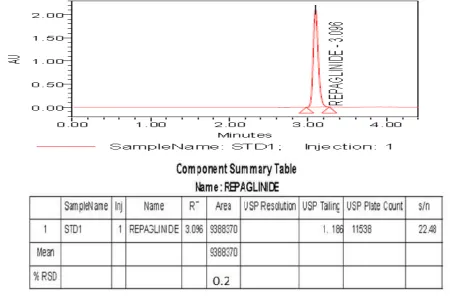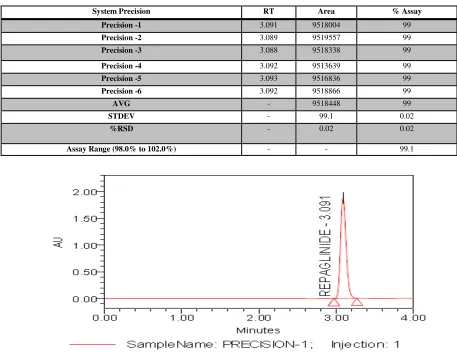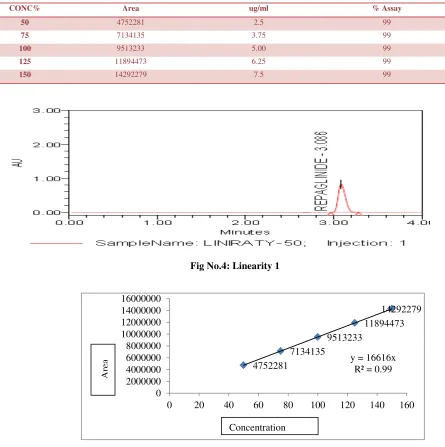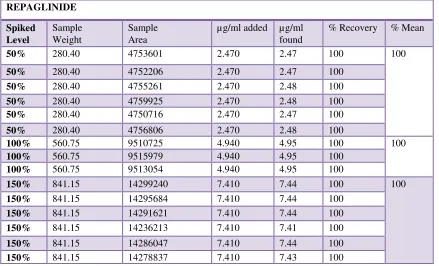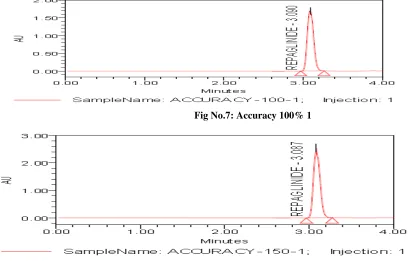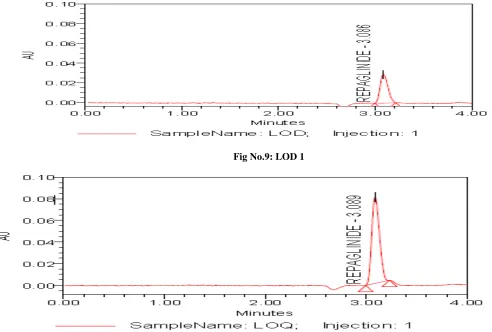w w w . i a j p s . c o m
Page 142
ISSN 2349-7750
I
IN
ND
DO
O
A
AM
ME
ER
RI
IC
CA
AN
N
J
JO
OU
UR
RN
NA
AL
L
O
OF
F
P
P
H
H
A
A
R
R
M
M
A
A
C
C
E
E
U
U
T
T
I
I
C
C
A
A
L
L
S
S
C
C
I
I
E
E
N
N
C
C
E
E
S
S
Available online at
:
http://www.iajps.com
Research Article
DEVELOPMENT AND VALIDATION OF REPAGLINIDE BY
REVERSED PHASE HIGH PERFORMANCE LIQUID
CHROMATOGRAPHY(RP-HPLC) IN TABLET DOSAGE
FORMS
Ayesha Begum K*, Sandhya Pamu, Geetha Kodali, Pavani Kasu
Shadan Womens College of Pharmacy, Khairatabad, Hyderabad - 500004.
Abstract
Repaglinide is an oral antihyperglycemic agent used for the treatment of non-insulin-dependent diabetes mellitus (NIDDM). A new RP-HPLC method was developed for the estimation of Repaglinide which is simple and less time consuming using an economical column. The analysis was resolved by using a mobile phase (Potassium di hydrogen phosphate: Methanol (80:20)) at a flow rate of 1 ml per minute using ACE- C18 (250 x 4.0, 5 microns) on an isocratic HPLC system. There was no interference observed from other impurities and Repaglinide has been eluted with good peak shape, response within 12 minutes and retention time at 3.016 minutes. The detection was made at 285 nm.The assay of the sample has been carried out using this new method and it was found to be 99.7%. The developed method has been validated for different parameters like Specificity, Precision, Linearity, Accuracy, Robustness, Limit of Detection (LOD) and Limit of Quantitation(LOQ) are studied as reported in the International Conference on Harmonization (ICH) guidelines. All the results obtained were within the acceptance limits indicating that the developed method is simple, specific accurate and economical. The method may now be recommended for routine and quality control analysis of Repaglinide.
Key Words: Repaglinide, Reversed phase high performance liquid chromatography, limit of detection and limit of quantitation.
*Corresponding author
Ayesha Begum K
w w w . i a j p s . c o m
Page 143
INTRODUCTION
Repaglinide is an oral antihyperglycemic agent used for the treatment of non-insulin-dependent diabetes mellitus (NIDDM). It belongs to the
meglitinide class of short-acting insulin
secretagogues, which act by binding to β cells of the pancreas to stimulate insulin release1. Repaglinide induces an early insulin response to meals decreasing postprandial blood glucose levels. It should only be taken with meals and meal-time doses should be skipped with any skipped meal. Approximately one month of therapy is required before a decrease in fasting blood glucose is seen. Meglitnides may have a neutral effect on weight or cause a slight increase in weight. The average weight gain caused by meglitinides appears to be lower than that caused by sulfonylureas and insulin and appears to occur only in those oral antidiabetic agents2.
Chemicals and Reagents used for the Study
1. Repaglinide working standard
(WS)
2. Repaglinide Sample
3. Methanol HPLC gradient water
4. High performance liquid
chromatography (Waters e2695)
5. Electronic Balance (sartorius)
6. Ultra Sonicator (Fast-Clean)
7. Thermal Oven (newtech lab
equipments)
8. Column (ACE- C18: 250 x 4.0 *5 µ)
9. Potassium hydrogen phosphate
Instrumentation used for the Study
High Performance liquid chromatography Agilent Technologies 1200 series with auto sampler and
Waters e2695 High Performance liquid
chromatography with auto sampler, Liquid
chromatogram equipped with maximum pressure 400 bar, Auto sampler, UV-Detector (Standard cell) and
data handling system (chemstation and LC solutions software).
Apparatus
Analytical balance, volumetric flasks, Pipettes, PH meter, Ultra Sonicator, Filtration unit and 0.45 µ membrane filters.
Preparation of Standard solution
Accurately weigh and transfer about 560.75 mg of Repaglinide Working standard in 100 mL volumetric flask. Add about 20 mL of mobile phase and sonicate to dissolve it completely and make up volume up to the mark with mobile phase. Dilute 10 mL of this solution to 10 mL in volumetric flask with the mobile phase (0.1 mg/mL).
Preparation of Test solution
20 tablets (Repaglinide) were weighed accurately to obtain the average tablet weight; the tablets were then crushed and triturated in a mortar until a fine powder was obtained. An amount of the powder equivalent to 560.75 mg of Repaglinide was weighed accurately and transferred to be examined in 50 ml volumetric flask and make up the volume to the mark with diluents using HPLC grade water and sonicate to dissolve it completely and make volume up to the mark with the same solvent.
RESULTS AND DISCUSSION 1. Specificity
Specificity is the ability to assess unequivocally the analyte in the presence of components which may be expected to be present. (Fig No: 2). Results are reported in Table 1.
System suitability
System suitability of test method has been demonstrated by injecting system suitability solution and standard solution as per described procedure (Fig No: 1).
Acceptance criteria: % RSD of assay of six preparations is NMT 2.00
Table No.1: Specificity Evaluation Comparing Retention Time Repaglinide RT Area
Inj-1 3.091 9518004
Inj-2 3.89 9519557
Inj-3 3.88 9518338
Inj-4 3.92 9513639
Inj-5 3.93 951886
Inj-6 3.93 9518448
AVG - 9518448
STDEV - 0.02
w w w . i a j p s . c o m
Page 144
Fig No.1: Specificity – System Suitability
w w w . i a j p s . c o m
Page 145
2. Presision
To experiment the repeatability of Standard solution obtained by this method. The precision has been demonstrated by preparing six standard solutions as per the test method. The precision of
method has been evaluated by computing the %RSD of the Area count (Fig No: 3). Results are reported in Table 2.
Acceptance criteria: %RSD of assay of six preparations is NMT 2.00
Table No.2: Precision
System Precision RT Area % Assay
Precision -1 3.091 9518004 99
Precision -2 3.089 9519557 99
Precision -3 3.088 9518338 99
Precision -4 3.092 9513639 99
Precision -5 3.093 9516836 99
Precision -6 3.092 9518866 99
AVG - 9518448 99
STDEV - 99.1 0.02
%RSD - 0.02 0.02
Assay Range (98.0% to 102.0%) - - 99.1
Fig No.3: Precision
3. Linearity
Demonstrates the linearity of analyte over the range of 50% to 150% of standard concentration.
Preparation of linearity stock solution
Accurately weigh and transfer about 560.75 mg of Repaglinide working standard in 250 mL volumetric flask, add about 250 mL of mobile phase and sonicate to dissolve it completely and make the volume up to the mark with mobile phase.
Inject these solutions into the HPLC system and record the area of analyte peak. Plot a graph of concentration (X-axis) vs. analyte peak (Y-axis).
Evaluate the correlation co-efficient between
concentration and peak area. (Fig No: 4 - 5). Results are reported in Table 3.
Acceptance criteria
w w w . i a j p s . c o m
Page 146
Table No: 3 Linearity
CONC% Area ug/ml % Assay
50 4752281 2.5 99
75 7134135 3.75 99
100 9513233 5.00 99
125 11894473 6.25 99
150 14292279 7.5 99
Fig No.4: Linearity 1
Fig No.5: Linearity graph
4. Accuracy
Accuracy of the test method has been demonstrated by preparing accuracy samples in 50 mL volumetric flask at the level of 50%, 100%, and 150% of samples concentration. The accuracy samples will be prepared in triplicate in each level.
Solution preparations: Accuracy 50%
Accurately weigh and transfer about 560.75 mg of Repaglinide test sample in three separate 100 mL volumetric flask. Add about 20 mL of mobile phase
and sonicate to dissolve completely and make up the volume up to the mark with mobile phase. Transfer 1 mL into a 10 mL volumetric flask using clean pipette and dilute to 10 mL with mobile phase (0.10 mg/mL) (Fig No: 6).
Accuracy 100%
Accurately weigh and transfer about 560.75 mg of Repaglinide test sample in three separate 100 mL volumetric flask. Add about 20 mL of mobile phase and sonicate to dissolve completely and make up the volume up to the mark with mobile phase. Transfer 1
4752281
7134135
9513233
11894473 14292279
y = 16616x R² = 0.99
0 2000000 4000000 6000000 8000000 10000000 12000000 14000000 16000000
0 20 40 60 80 100 120 140 160
Ar
ea
w w w . i a j p s . c o m
Page 147
mL into a 10mL volumetric flask using clean pipetteand dilute to 10 mL with mobile phase (0.20 mg/mL) (Fig No: 7)
Accuracy 150%
Accurately weigh and transfer about 560.75 mg of Repaglinide test sample in three separate 100 mL volumetric flask. Add about 20 mL of mobile phase and sonicate to dissolve completely and make up the
volume up to the mark with mobile phase. Transfer 1 mL into a 10mL volumetric flask using clean pipette and dilute to 10 mL with mobile phase (0.30 mg/mL) (Fig No: 8).
Results are reported in Table 4.
Acceptance criteria
The Recovery for all levels should be between 98%-102%.
Table No. 4 Accuracy REPAGLINIDE
Spiked Level
Sample Weight
Sample Area
µg/ml added µg/ml
found
% Recovery % Mean
50% 280.40 4753601 2.470 2.47 100 100
50% 280.40 4752206 2.470 2.47 100
50% 280.40 4755261 2.470 2.48 100
50% 280.40 4759925 2.470 2.48 100
50% 280.40 4750716 2.470 2.47 100
50% 280.40 4756806 2.470 2.48 100
100% 560.75 9510725 4.940 4.95 100 100
100% 560.75 9515979 4.940 4.95 100
100% 560.75 9513054 4.940 4.95 100
150% 841.15 14299240 7.410 7.44 100 100
150% 841.15 14295684 7.410 7.44 100
150% 841.15 14291621 7.410 7.44 100
150% 841.15 14236213 7.410 7.41 100
150% 841.15 14286047 7.410 7.44 100
150% 841.15 14278837 7.410 7.43 100
w w w . i a j p s . c o m
Page 148
Fig No.7: Accuracy 100% 1
Fig No.8: Accuracy 150% - 1
5. LOD and LOQ
The Limit of Detection (LOD) and Limit of Quantitation (LOQ) of REPAGLINIDE by the proposed methods were determined using calibration standards. LOD and LOQ were calculated as 3.3 s/S and 10 s/S, respectively, where
S is the slope of the calibration curve and s is the standard deviation of y-intercept of regression equation. The results of the same are shown in Table5, 6. The low values indicated the good sensitivity of the method proposed (Fig No: 9 - 10).
Table No. 5: LOD and LOQ
Analyte LOD LOD LOQ LOQ
Concentration (mg/ml) S/N ratio Concentration (mg/ml) S/N ratio
Repaglinide 2.5 0.667 6.25 2.224
w w w . i a j p s . c o m
Page 149
Fig No.9: LOD 1
Fig No.10: LOQ 1 6. Robustness:
To establish the robustness of test method and to demonstrate its reliability for minor changes in chromatographic conditions (Fig No: 11). Robustness of
test method will be demonstrated by carrying out system suitability under normal condition and each of the altered conditions. Results are reported in Table 7, 8.
Table No. 7: Robustness
S.No Sample Name RT Area USP Tailing USP Plate
count
s/n
1 TEMP1 3.9 1194 1.229 7735 1272.78
2 TEMP2 3.1 9486 1.198 8767 1970.77
3 FLOW1 3.1 9440 1.201 8549 1888.12
4 FLOW2 3.1 9454 1.23 8606 1735.58
MEAN 112.5
%RSD 0.02
Table No. 8: Robustness
S.NO
Parameter Normal condition Altered condition-1 Altered condition-2
1. Flow rate 0.8 mL/min 0.6 mL/min 1 mL/min
w w w . i a j p s . c o m
Page 150
Fig No.11: Robustness 1
Acceptance criteria
Following system suitability parameters to be evaluated should comply with all altered conditions.
%RSD for area response of Repaglinide peak obtained with altered conditions NMT 2.00
no. of theoretical plates for repaglinide peak in altered conditions: NLT 3000
CONCLUSION
The proposed method is suitable for the estimation of Repaglinide which is simple, less time consuming using an economical column. The developed method has been validated for different parameters like Specificity, Method Precision, System Precision and Intermediate precision, Intermediate precision Analyst-II, Linearity, Accuracy and Robustness. All the results obtained were within the acceptance limits indicating that the developed method is simple, specific accurate and economical. This method may now be recommended for routine and quality control analysis of Repaglinide.
REFERENCES
1. Analytical Sciences. The International Journal of Japan Society of Analytical Sciences.2003 19(12):1675-7.
2. Dhole,SM, Khedekar,PB, Amnerkar,ND.Pharmce
utical Methods. 2012 Jul; 3(2):68-72. Doi: 10.4103/2229-4708.103875.
3. Kaushal N, Jain S, Tiwary AK. Indian Journal of
Pharmaceutical Sciences. 2010 Mar; 72(2):244..
4. Kaushal N, Jain S, Tiwary AK. Indian Journal of
Pharmaceutical Sciences. 2010 Mar; 72(2):240-4. 5. S. G. Weber & P. W. Carr; High Performance Liquid Chromatography; Wiley, Interscience; New York ; 1989.
6. S. Vander Waal & L. R. Snyder; Journal of Chromatography ; 225 ; 1983 ; 463
7. Validation of analytical procedure: methodology,
ICH harmonized tripartite guideline, (1996).
8. Lyoyd R.Snyder, Joseph J.Krikland and Joseph

